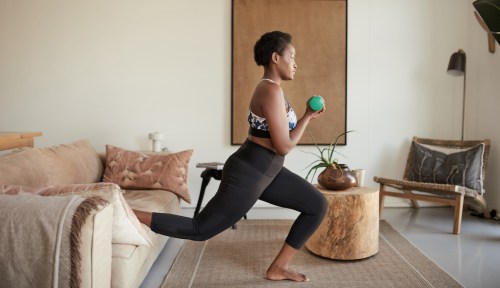With Weight Training, Is It Better To Go Heavier or Do More Reps?
Here's what to know.

Grab those kettlebells and break out the hand weights, and get ready to improve your weight-lifting game. Adding weight training to your workout routine is essential for increasing muscle mass, while also ensuring you aren’t losing muscle mass over time. But when it comes to weight training, should you opt for heavier weights with fewer reps or lighter with a higher rep count? Roxie Jones, personal trainer, nutrition coach, and the creator of BodyRox, says it is all about meeting your individual needs and goals.
Experts in This Article
certified functional strength coach and founder of BodyRox
In general, higher reps with lower weight helps build endurance, while using heavier weights during shorter sets build mass. “If you are a beginner, it’s always recommended to start with lighter weights and more reps so you can better understand form and also be able to adjust to the training stress on the body,” says JOnes.
For a beginner to the weight training world, the Mayo Clinic recommends choosing a weight level that will tire your muscles in 12 to 15 repetitions. After one set, you should need that recovery period to reset and catch your breath before set number two. In this sweet spot, you are ensuring your muscle group hits the point of fatigue, while also reaching a level of aerobic activity that gets your heart rate up and targets strength building. Mayo Clinic also recommends adding strength training exercises for all major muscle groups at least two times a week for 20 to 30 minutes. When starting out, try a sequence that focuses on bodyweight strengthening like push-ups, planks, squats, and lunges.
Here, trainer Kat Atienza takes us through a 20 minute full-body strength workout that requires no weights and gets your body moving and strengthened, and your form perfected:
Once you have your form down, adding weight volume to your routine and increasing your overall strength—looking at you, deadlift PRs!—might become a training goal. At this stage, Jones recommends shifting your training approach and adjusting your rep count and weights. “As you adapt, you can then start to reduce the volume, or number of reps, and increase the weight to build more strength,” she says.
Be sure and not take on too much too quickly. Practice the thinking of “slow and steady” and make sure to gradually increase your weight to avoid injury.
Ready to challenge yourself? Amber Rees and Lindsey Clayton: senior instructors at Barry’s, co-founders of Brave Body Project, and Puma athletes, work the triceps, biceps, shoulders, and core using medium weights in this 15-minute arms and abs strength workout:
Oh hi! You look like someone who loves free workouts, discounts for cult-fave wellness brands, and exclusive Well+Good content. Sign up for Well+, our online community of wellness insiders, and unlock your rewards instantly.
Sign Up for Our Daily Newsletter
Get all the latest in wellness, trends, food, fitness, beauty, and more delivered right to your inbox.
Got it, you've been added to our email list.










